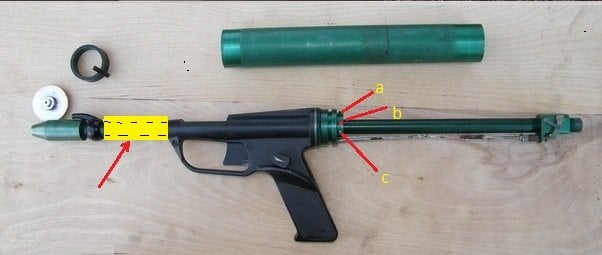Another speargun from the Arsenal plant in Ukraine was the RPS-5 which was a mid-handle pneumatic. These guns were produced in what was then the USSR and provided local spearfishermen with underwater weapons suited for their hunting environment and types of prey. Hunting was carried out in rivers and lakes and other inland reservoirs that provided a range of freshwater fish, but visibility under gritty conditions with any current running meant shots would mainly be at close range. These waters were not devoid of big fish as there were European Carp and Catfish to skewer, however monsters such as Sturgeon were off limits, probably due to the Caviar industry wishing to preserve fish stocks.



Note that these guns string their shooting line wraps on top of the gun between a plastic front wrap hook set back from the muzzle and a rear passive line clip also made of plastic. The guns are not as heavy as they look as that big air tank has not much in it and the plastic handles are relatively slim when viewed from end on, however the guns don't float after the shot. Note that there are no muzzle relief ports, so the guns will have hydrobraking during the shot.
When you pull the triggers they slide in the grips, so they operate push rods inside the gun.
Note that these guns string their shooting line wraps on top of the gun between a plastic front wrap hook set back from the muzzle and a rear passive line clip also made of plastic. The guns are not as heavy as they look as that big air tank has not much in it and the plastic handles are relatively slim when viewed from end on, however the guns don't float after the shot. Note that there are no muzzle relief ports, so the guns will have hydrobraking during the shot.
When you pull the triggers they slide in the grips, so they operate push rods inside the gun.
Last edited:



